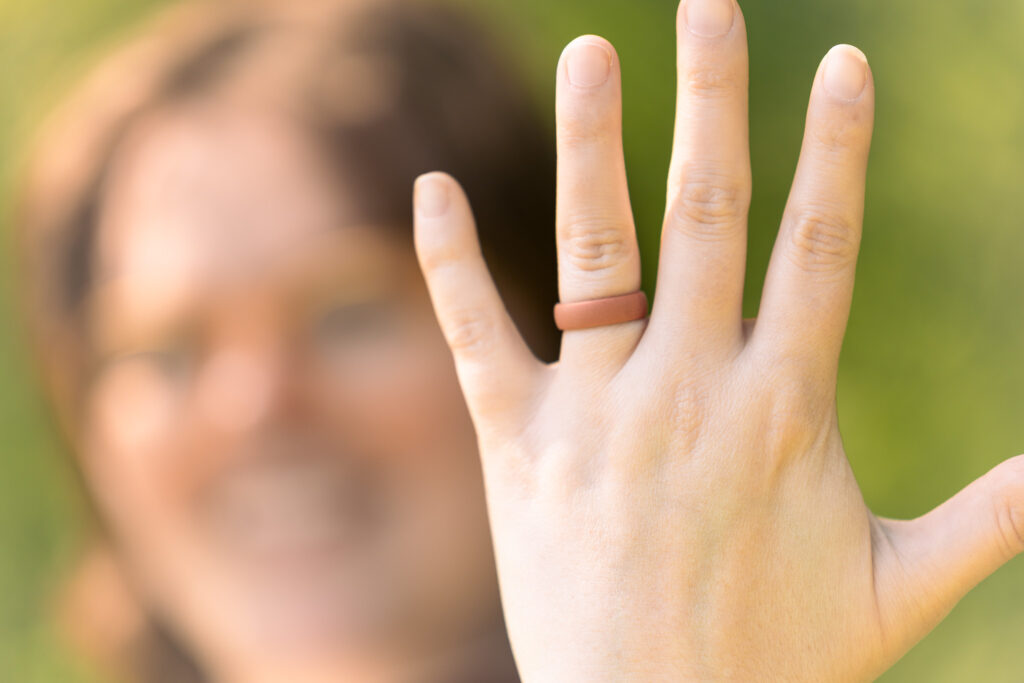Before every camping trip, I go through the usual pre-departure checklist: pack the sleeping bags, prep the cooler, double-check the headlamp batteries. But there’s one more thing I always make sure to do before heading out—I leave my wedding ring at home.
It’s not because I don’t love my spouse or want to pretend I’m not married (believe me, he’s my favorite camping buddy). It’s because I want to keep my ring—and my finger—safe.
Wedding rings are meaningful and often expensive, and the outdoors isn’t always the most forgiving environment for fine jewelry. Between setting up tents, starting campfires, swimming in lakes, and scrambling up rocks, I’ve found that camping just isn’t the best place for something as delicate (and valuable) as a wedding ring.
Instead, I wear a simple silicone band while I’m out in nature. It’s lightweight, low-profile, and gives me peace of mind. I don’t have to worry about scratching or losing my real ring, and even more importantly, I don’t have to worry about it getting caught on anything and injuring my finger.
Why It’s Best to Keep Your Ring at Home for Adventures
There are a few solid reasons I opt to leave my wedding ring behind:
- It’s expensive: My ring isn’t just a piece of jewelry—it’s an investment and a sentimental heirloom. I’d rather not risk losing it in a river or having it bounce off a trail somewhere in the woods.
- Rings can get damaged outdoors: Even the toughest metals can get scratched, dented, or warped if you’re doing enough manual labor—which, let’s face it, camping usually involves. Add dirt, rocks, firewood, and a few tent stakes into the mix, and it’s easy to see how quickly your ring can take a beating.
- Safety is a real concern: It’s not just about damaging the ring. A metal band can get caught on gear, tree branches, or even climbing holds. This might sound dramatic, but ring avulsion—where the ring catches on something and injures your finger—is very real and very unpleasant. (You can read more about the injury here, but I’m here to say that it isn’t for the squeamish.) A silicone band, on the other hand, will break away safely under pressure.
To me, these dangers make it a no-brainer. I’d always rather be safe than sorry!
Wedding Ring Alternatives for Outdoorsy People
Wearing a silicone band has been the perfect solution. It’s comfortable, flexible, and incredibly affordable. I don’t think twice about it while I’m hiking, setting up camp, or washing dishes at the campground. It still shows that I’m married, but it doesn’t carry the same stress or risk.
There are tons of options out there in different styles and colors, so it’s easy to find one that fits your vibe. Some even have subtle designs or textures to mimic a traditional band if you like that look.
Other Ring Options to Consider
Not into silicone rings? Here are a few other things you can do:
- Wear your ring on a necklace. If you still want to bring it along, threading your ring onto a chain and wearing it around your neck can keep it close without keeping it on your hand. Just make sure the clasp is sturdy.
- Use a travel ring. Some people opt for a cheaper metal ring to wear on trips—something that looks nice but won’t be a big loss if it disappears in a lake or gets dinged up on a rock.
- Go ring-free. There’s absolutely no rule that says you have to wear a ring, especially when you’re off the grid. Your relationship doesn’t depend on a visible symbol—and you can always slip it back on when you’re home.
The Bottom Line
At the end of the day, it’s totally up to you. But for me, camping is about simplifying things, and that includes my jewelry. Swapping my wedding ring for a silicone band helps me stay focused on the fun—and makes sure I come home with all ten fingers and no regrets.


